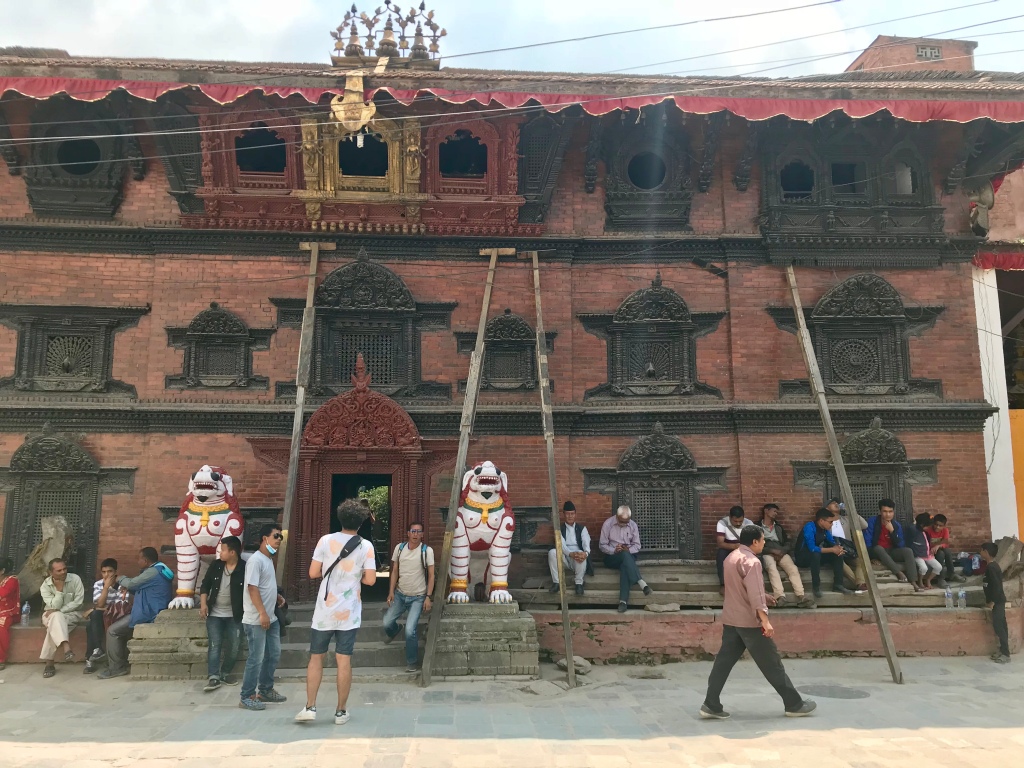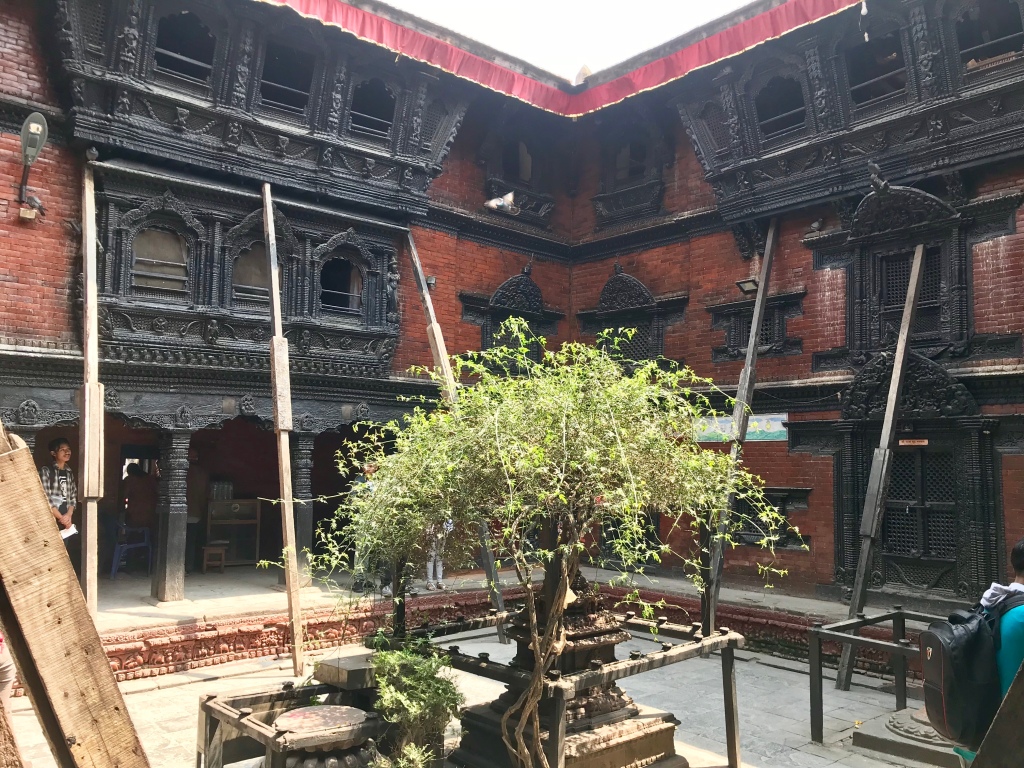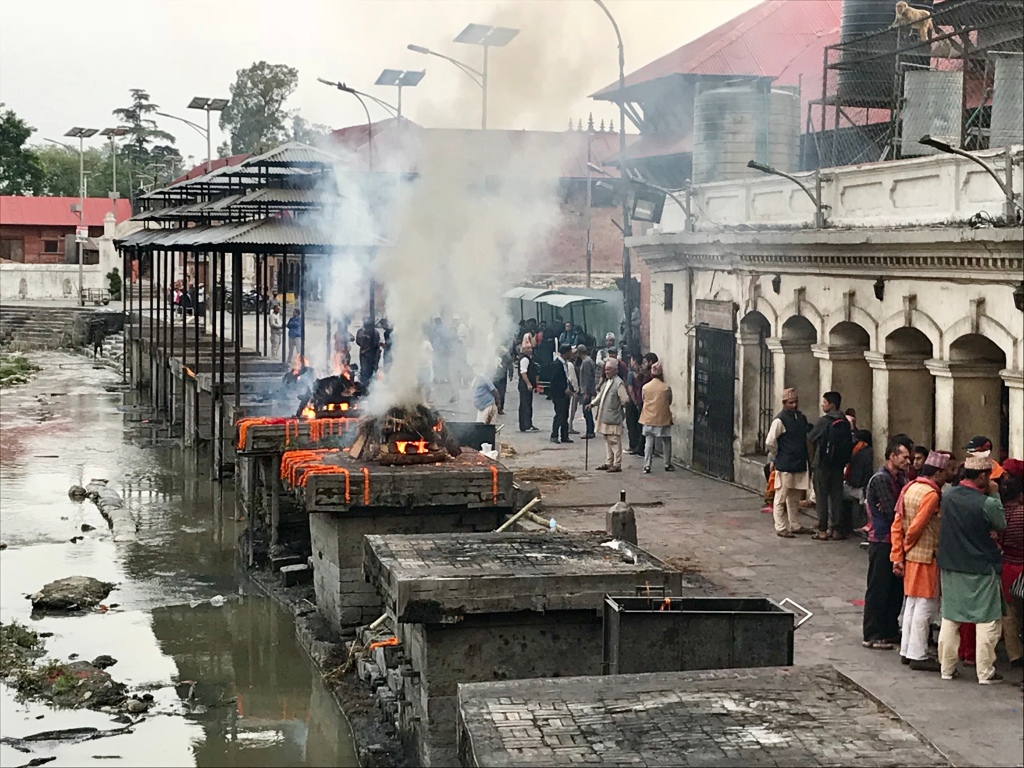I had to take a few days after arriving in Kathmandu to process all of the fascinating and mind-bending sights. After some initial culture shock, I have found that I kind of like how rugged this city is. In 2015, Nepal was devastated by a series of earthquakes registering around 8ish on the Richter scale. The earthquakes killed nearly 9,000 people and toppled thousands of buildings. It also caused an avalanche on Mt. Everest that killed 21 people making it the deadliest day on the mountain—ever. While walking around, you can still clearly see the impact the earthquakes had, as many buildings are propped up with poles, others have massive cracks and many still lie in rubble piles of concrete, bricks and stone. In fact, after the earthquakes the city sent a team of engineers around to label buildings according to safety level and placed stickers with red, yellow and green to indicate, well, how likely the building is to crush the inhabitants. Further adding to the chaos of the place, the streets are only half-paved so cars and bicycle rickshaws kick up an insane amount of dust, blanketing virtually everything both indoors and out. On a walk around town, it is not uncommon to see slabs of raw meat for sale on tables outside, vendors pushing bicycles overladen with fruit, and groups of taxi drivers chit-chatting as they wait around for passengers. But in direct contrast to the grit, one can find beautiful women wearing stunning, intricate saris of red or pink. (In fact, Falcon offered to wake up early every morning to paint my clothes to make them prettier and brighter if I wanted.) The women put a red powder dot on their foreheads for good luck, and another smudge in their hairline to indicate that they are married. Men often hold hands or touch each other’s backs in a display of refreshing platonic affection that would send homophobic folks into fits. Combine all this with honking traffic, burning incense, people hawking yak wool blankets and trekking gear, delectable but bowel-melting Indian curries, obscenely grimy squat toilets and shredded prayer flags flapping in the wind, and you get a small idea of what this town is like.
One day, as we were walking around the toppled buildings of Durbar Square, a sun-beaten and weathered man thrust a crumpled postcard of a child dressed up for a festival at me and whispered harshly, “I can take you to see the Living Goddess.” As a rule, I always say no to whatever it is. A split second of hesitation as you process whatever is said, allows a vendor/tour guide/hawker to pounce and you will spend the next 10 minutes or more trying to rid yourself of the hanger-on. But my interest had been piqued so I went home and googled it. I seriously doubted that I had heard correctly or that it was as dramatic as I imagined, but low and behold, there was truly a living, breathing God holed up in a palace 10 minutes from my hotel.

The Royal Kumari, as she is called, is girl of 5 years old (as of 2019). Although her life began as a mere mortal baby, she was selected to serve as the living deity at the ripe age of 3 by exhibiting a number of important qualities and skills. The reason for which I’m not even going to try to explain. The Cliff Notes version of the selection process goes something like this: In order to be considered as a potential Kumari, one must have a neck like a conch shell, the body of a banyan tree and eyelashes like a cow, among many other attributes. She must also have not lost any teeth, be unblemished in physical appearance and health, and be from the Shakya caste. Once a child of the perfect aesthetic is found, she must then endure tests of her bravery by spending the night with the decapitated heads of sacrificial animals in a candle lit temple. The final test of the Kumari is to select the previous child-God’s belongs from an array of objects. If she fails this test, a new candidate is brought in for examination. Once the tests are complete and a series of cleansing rituals are performed on her body and soul, the deity enters her body and she remains divine until her first menstruation or until she bleeds heavily due to illness or wound.
She is confined to her palace in Kathmandu. The Kumari leaves only for ceremonies and is paraded through the streets on a palanquin, never wearing shoes or walking in public again. She is dressed only in red and always has a “fire eye” painted on her forehead. Yearly, the King seeks her out and kisses her feet in exchange for her blessing. She presides over a selected handful of gift-baring devotees that have come to her palace hoping that her power will heal their illnesses or predict their futures. The intriguing bit of all this is that once she is divine, she has very little contact with her family. She has caretakers and a refined group of playmates that are well-aware of the strict rules regarding her holiness. While the Living Goddess cannot be ordered to do anything, she must still be guided through life, bathed, educated and instructed on how to behave.

I can’t help but think about my own two children as I read all this. One of my children is 3 and the other is 5, and generally speaking, I find them to be pretty clumsy, emotional, loud things, with infrequent bouts of incitefullness, mediocre tact and adorable naivte. I love them because they are my little snuggle muffins, but I can’t even imagine what it would be like if they ruled with unrestricted abandon as the Kumari does. I can barely get my kids dressed to go out in the morning, let alone force them to wear formal garb and allow strangers to kiss their feet day in and day out. Although, they would be delighted to receive presents and be carried around all day.
That’s when I read the best part of the entire Wikipedia article: how to interpret the Kumari’s actions during a visit with her holiness. Typically, the Living Goddess will receive her guests in silence and this is considered the best outcome. However, if she cries or laughs during a visit, it can be a sign of impending illness. If she rubs her eyes, one can expect imminent death. If she claps, one should fear the King, and if she picks at the food offered to her, one can expect financial woes. Essentially, she acts just like a regular kid.

The front of the palace 
The interior courtyard
The Kumari Ghar (her palace) was too close not to go see for myself. I headed back to the square where I first heard about the Living Goddess. I wandered around looking for a red palace in all the broken-down rubble buildings, maybe one with surrounded by people hoping to catch a glimpse of the elusive child. I walked and walked, and finally found what I was looking for. It was much smaller than I expected. It was said to be a sign of her omnipotence that her palace remained relatively intact following the earthquakes, given the fact that many of the surrounding buildings had been flattened. Ornately carved window boxes surrounded the 3-story building, but other than that, it really didn’t look like the home of a divine being. I passed the threshold and cautiously entered the internal courtyard of the building, expecting that I was going to be escorted out for trespassing or not being Hindu. But alas, my expedition went unchallenged. I walked around the small courtyard hoping that she might make an unscheduled appearance at the window. Tourists came in, posed for Instagram selfies, got bored and left. Unsanctioned tour guides popped in, attempted to gain employment, gave up and left. And at no point during my visit, did I hear a peep from the open-air windows of the palace that would indicate that there may be a child or children present. Eventually, I too lost interest and left while the Living Goddess of Kathmandu remained just as elusive and mysterious as she started.





